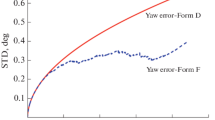Abstract
During the last years integrated navigation systems based on gyros,accelerometers, and satellite navigation receivers became powerful,favourably priced devices for the guidance of aircraft and ships.Comparable equipment using especially wheel sensors exists for cars. Thekernel of such systems is a Kalman filter estimating the relevantvehicle motion. The filter design in turn requires a kinematical modelto settle on the motion components considered and to describe themechanical meaning of the measurements employed. Up to now, usual modelsrepresent a single rigid body with two, three or six degrees of freedom.
The assumption of a solitary rigid body reflects mainly classicalnavigation requirements, it is not a consequence of the basic concept ofintegrated navigation systems. In principle, determining the motion ofmechanical systems with other or with additional degrees of freedom ispossible if appropriate kinematical models and suitable sensorarrangements are available.
Based on the theory of integrated navigation systems, the paperdescribes the fundamentals of the design of integrated motionmeasurement systems for multibody structures. The approach isfurthermore illustrated by the example of a double pendulum with amovable inertial support and equipped with microelectromechanical gyrosand accelerometers as well as with radar units. The attachment of thesensors demonstrates that a measurement system layout does typically notrequire considerable modifications of already existing mechanicalassemblies. The performance of the integrated system for the pendulum isdemonstrated by means of simulated and of experimental sensor signals.
Similar content being viewed by others
References
‘Gyrostar® Piezoelectric Vibrating Gyroscope ENC Series. Rev.-No. S42E-2’, Murata Manufacturing, Kyoto, 1999.
‘iMEMS® Accelerometer ADXL105-Specifications. Rev. A’, Analog Devices, Norwood, MA, 1999.
Betzold, M., ‘Aufbau eines Systems zur parallelen Datenerfassung in einem Nahbereich-Radarnetzwerk’, Student Thesis, Technical University, Institute of Telecommunications, Hamburg-Harburg, 2000.
Bremer, H. and Pfeiffer, F., Elastische Mehrkörpersysteme, Teubner, Stuttgart, 1992.
Brown, R., ‘Receiver autonomous integrity monitoring’, in Global Positioning System, Theory and Applications, Vol. II, B. Parkinson and J. Spilker (eds.), AIAA, Washington, DC, 1996, 143–165.
de Marées, H. and Mester, J., Sportphysiologie III, Diesterweg, Frankfurt am Main, 1984.
Everett, H., Sensors for Mobile Robots, Peters, Wellesley, MA, 1995.
Farrell, J. and Barth, M. The Global Positioning System and Inertial Navigation, McGraw-Hill, New York, 1999.
Gelb, A. (ed.), Applied Optimal Estimation, 11th edition, The MIT Press, Cambridge, MA, 1989.
Hiller, M., Mechanische Systeme, Springer-Verlag, Berlin, 1983.
Hong, S., Lee, M.-H., Rios, J. and Speyer, J., ‘Observability analysis of GPS aided INS’, in Proceedings of ION GPS 2000, Salt Lake City, UT, September 19–22, The Institute of Navigation, Alexandria, VA, 2000, 2618–2624.
Klotz, M. and Rohling, H., ‘24 GHz radar sensors for automotive applications’, in MIKON-2000: XIII International Conference on Microwaves, Radar and Wireless Communications, Wroclaw, May 22–24, Telecommunications Research Institute, Warsaw, 2000, 359–362.
Lawrence, A., Modern Inertial Technology, Springer, New York, 1993.
Levine, W. (ed.), The Control Handbook, CRC Press, Boca Raton, FL, 1996.
Magnus, K., Kreisel, Theorie und Anwendungen, Springer-Verlag, Berlin, 1971.
Maluf, N., An Introduction to Microelectromechanical Systems Engineering, Artech House, Boston, MA, 2000.
Otto, S., ‘Messung von Inertial-und Stützgrößen an einem Doppelpendel zur Bewegungsermittlung durch ein integriertes Messverfahren’, Student Thesis, Technical University, Institute of Mechanics and Ocean Engineering, Hamburg-Harburg, 2003.
Stieler, B., ‘Gyros for robots’, in Symposium Gyro Technology 1999, Stuttgart, September 14–15, H. Sorg (ed.), University of Stuttgart/DGON, Stuttgart, 1999, 9.1–9.13.
Titterton, D. and Weston, J., Strapdown Inertial Navigation Technology, Peter Peregrinus/IEE, London, 1997.
Wagner, J., Lippens, V., Nagel, V., Morlock, M. and Vollmer, M., ‘Generalising integrated navigation systems: The example of the attitude reference system for an ankle exercise board’, in Symposium Gyro Technology 2001, Stuttgart, September 18–19, H. Sorg (ed.), University of Stuttgart/DGON, Stuttgart, 2001, 18.1–18.16.
Wagner, J. and Kasties, G., 2002, ‘Improving the GPS/INS integrated system performance by increasing the distance between GPS antennas and inertial sensors’, in Proceedings of the 2002 National Technical Meeting, San Diego, CA, January 28–30, The Institute of Navigation, Alexandria, VA, 2002, 103–115.
Wagner, J. and Wieneke, T., ‘Satellite and inertial navigation — Conventional and new fusion approaches’, Control Engineering Practice 11(5), 2003, 543–550.
Weidmann, W. and Steinbuch, D., ‘A high resolution radar for short range automotive applications’, in Conference Proceedings of the 28th European Microwave Conference, Amsterdam, October 6–8, Miller Freemann, London, 1998, 590–594.
Author information
Authors and Affiliations
Rights and permissions
About this article
Cite this article
Wagner, J. Adapting the Principle of Integrated Navigation Systems to Measuring the Motion of Rigid Multibody Systems. Multibody System Dynamics 11, 87–110 (2004). https://doi.org/10.1023/B:MUBO.0000014902.22416.90
Issue Date:
DOI: https://doi.org/10.1023/B:MUBO.0000014902.22416.90




